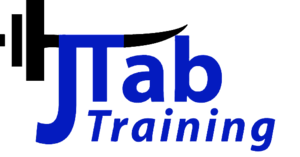I started my journey with Jtab Training in the spring of 2015. At the time my goal was to lose weight and tone up before my wedding that summer. I had never weight trained before, but as someone who had never been a fan of exercise, I was always on a mission to find something I could stick with.
I fell in love with strength training. In my 20’s it was a way to keep my weight down and look good in a dress. It was easy to stick to my 2 day a week routine, because the results were obvious and visible.
When I got pregnant with my first child in 2017, I used my time at Jtab to ensure I had a healthy pregnancy, free from as much discomfort as I could possibly be. And it worked! Toward the end of my pregnancy, I was in the gym just days before my daughter was born. The strength training I did while pregnant allowed me to have the endurance to push through 18 hours of unmedicated labor. I credit each of those workouts as giving me he strength I needed to get through those first few overwhelming weeks with a newborn.
After her birth, I was back in the gym 8 weeks later. This time my goal was to get as close as I could to my pre-pregnancy body. I used my time to restrengthen muscles that had laid dormant for weeks, and shed the excess fat that had accumulated from a few too many pregnancy cravings. It was tough at first, between balancing life with a new baby, a business, and a body that couldn’t do the things it used to. It felt like “starting over” again, building slowly back to up to weights that would have been easy for me pre-baby. But by sticking through it, I was able to hold an increasingly heavy baby, which become chasing after an increasingly mobile toddler.
Then the pandemic hit. And my goals shifted again. Working out no longer was strictly about how my body looked. It became an outlet for my sanity. It provided me a way to work through my frustrations at being locked in a house for months with a bored toddler. It was a way to process my emotions about losing my clients, one by one, as their business doors were shuttered from pandemic closures. It was a way to shift my attention away from the fear, and anxiety, and uncertainty, at least for a little while, and focus on self care.
However, like all businesses, the shut down of the Jtab gym and quarantine, meant I had to find this outlet at home now. And while that was good at the time, it meant that when the gym finally reopened, it felt like restarting again in a way. I didn’t have heavy weights at home, and going months without lifting them meant starting back towards the beginning again.
When I got pregnant again in early 2021, the plan was to continue to workout through my entire pregnancy. However, this time, things didn’t go completely as planned. Between a car accident that put me in early labor (and subsequently on multiple rounds of rest), and a toddler whose school was consistently being shut down during a Covid spike, I didn’t make it in nearly as much as I wanted to.
When my son was born in December, I realized what a toll this pregnancy took on my body. I had gained significantly more weight this time around, and now months of not working out lead to a weak back, diastases separation in my core, and arms and legs that tired easy.
Now 11 weeks postpartum I finally returned to the gym. I am still 20 lbs heavier than I want to be, and can lift significantly less than I could before I left, but I’m ready to start over again. My strength training journey has been a series of starts and restarts, but it’s been the only thing I’ve been able to stick with for all these years now. I may not always be where I want to be physically, but I know that staying consistent in my workouts is the only way I’m going to achieve my new goals. Goals which now include a little bit of everything - to stay strong and healthy for my kids, to maintain my sanity, and of course, to fit back into my jeans again.
I think the point of my story is to show that everyone’s relationship with working out changes and evolves over time. Your exercise journey is never a straight line up. It often includes hills and valleys, and could include multiple restarts, like mine does.
It doesn’t matter if your coming off of a pregnancy, an injury, an illness, or just a busy time in your life. It doesn’t matter if your goals are mental, physical, or to be able to button up your jeans again. Jtab welcomes everyone, and will create custom programs to help you achieve those goals, and maybe surpass what you even thought you would be able to do.

